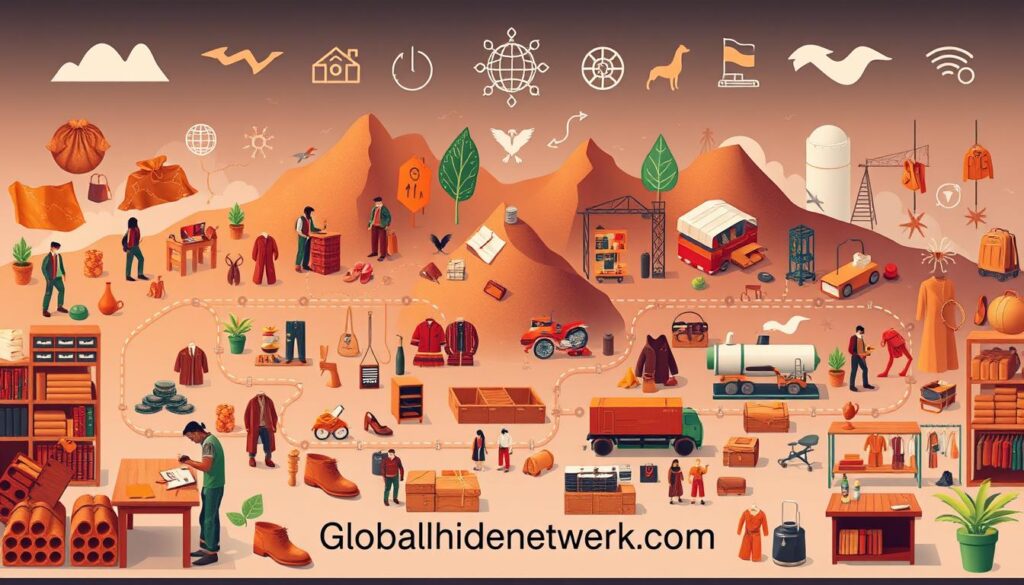I’ve seen a big problem in the leather world. Many brands have trouble showing where their leather comes from. This makes it hard to follow rules and keeps customers from trusting them.
Bad supply chain management can hurt a lot. Brands might face big fines, lose their good name, and see their sales drop. Without good data, meeting rules and keeping customers happy is almost impossible.
But there’s a way out. By getting better at managing their supply chain, brands can turn things around. Using strong traceability and focusing on being green can make them stand out. It’s time for brands to take charge of their data and secure their future.
Key Takeaways
- Traceability is now essential in the leather industry
- Effective data management ensures regulatory compliance
- Sustainability drives consumer trust and brand loyalty
- Supply chain transparency is crucial for market competitiveness
- Implementing traceability systems can provide a competitive edge
The Evolution of Leather Supply Chain Management
The leather industry has changed a lot over time. Globalization has changed how leather is made and sold. Let’s look at how it has evolved and the challenges it faces today.
Historical Perspectives on Leather Production
Leather making has been around for centuries. Old ways used local materials and methods. Now, the scene is very different.
The top 5 countries – China, Brazil, Russia, India, and Italy – make 55% of the world’s leather. China makes the most, with 35.6% of it.
Modern Challenges in the Leather Industry
The industry faces many challenges. Environmental issues are a big concern. Leather making uses about 500 kg of chemicals per ton of raw hides.
This leads to water pollution. It also risks the health of workers and those who use leather products. Volatile organic solvents and PFCs in leather finishing are especially risky.
The Impact of Globalization on Leather Supply Chains
Globalization has changed the leather industry a lot. Raw materials often come from places like Australia and Brazil. Labor-intensive work happens in countries with lower labor costs, like China, Vietnam, India, or Indonesia.
This global setup brings its own set of problems. The World Trade Organization says 20-30% of greenhouse gas emissions in the last decade came from moving goods around. It’s now very important to know where materials come from.
Companies like The ID Factory are working on systems to track materials in the supply chain. As the leather industry keeps changing, solving these problems is crucial for its future.
Understanding Leather Supply Chain Management
Mastering Leather Supply Chain Management is key today. The Leather Impact Accelerator (LIA) guides on mapping and traceability. This makes brands more open, cutting down risks and improving talks with stakeholders.

Data management is crucial. Companies should track materials from start to finish. Tools like SourceMap and ChainPoint help with this. The aim is to have reliable tracking across the industry.
Working with stakeholders is also important. Brands need to team up with suppliers, getting all the details. This teamwork is needed inside the company too, making sure everyone supports traceability efforts.
- Brands have 5-10 years to map their supply chains
- Suppliers must give full contact info
- It takes time and money to set this up
I’ve seen a move towards green practices in the leather world. Companies like Green Hides and Issara focus on eco-friendly methods. They use chrome-free tanning and make leather on demand. This meets the growing need for leather made responsibly, keeping quality high while caring for the planet.
Raw Material Sourcing: The Foundation of Quality Leather
I’ve learned that finding the right raw materials is key in the leather industry. It’s the first step to making products that people love. Let’s explore how we can improve this process for everyone.
Identifying Premium Hide Sources
Finding the best hides is crucial. Cows, pigs, goats, and sheep are common sources. Each has its own qualities.
Cowhide is tough, perfect for furniture. Goat leather is soft, great for gloves. Knowing these differences helps me choose the right material for each product.
Sustainable Sourcing Practices
Sustainability is important in leather sourcing. Some farms use rotational grazing to reduce carbon footprints. I’m always looking for ways to lessen environmental impact.
Did you know the fashion industry uses 1 trillion kilowatt hours yearly? That’s 10% of the total carbon impact! It’s clear we need to focus on sustainable practices.
Building Relationships with Suppliers
Strong supplier relationships are vital. I work closely with my suppliers to ensure quality and ethical practices. We set clear expectations for material types, quantities, and budgets.
Regular performance reviews help maintain high standards. By fostering these relationships, I can create a more transparent and responsible supply chain.
| Criteria | Supplier A | Supplier B | Supplier C |
|---|---|---|---|
| Quality Certifications | ISO 9001, LWG | ISO 14001 | REACH, LWG |
| Production Capacity | 50,000 sq ft/month | 30,000 sq ft/month | 40,000 sq ft/month |
| Lead Times | 4-6 weeks | 3-5 weeks | 5-7 weeks |
| Price Competitiveness | Medium | High | Low |
Tannery Operations: The Heart of Leather Processing
Tanneries are key in making leather. They turn raw hides into strong, flexible materials we all use. The mix of old ways and new tech is fascinating.
Tanneries have changed a lot. Chrome tanning is big, making up over 80% of leather. But, green tanning is becoming more popular. Now, vegetable tanning can make quality leather in just two days.
The leather world has big data and green issues. Tanneries need to manage lots of info. They must connect different systems to keep everything straight.
Green rules are changing leather making. Tanneries in Europe must follow strict water rules. The goal is to make leather safer and cleaner.
| Tanning Method | Market Share | Processing Time |
|---|---|---|
| Chrome Tanning | 80% | 24 hours |
| Vegetable Tanning | 20% | 2 days |
New, green tanning agents are coming. Zeology® meets strict green standards. Ecotan® is another option that’s better for the planet. These changes are making leather making greener.
Inventory Control Strategies for Leather Businesses
Inventory control is key for leather businesses. It’s about having enough stock and not too much. This balance is crucial for success.
Implementing Just-in-Time Inventory Systems
Just-in-time systems change the game for leather supply chains. They match stock levels with production needs. This cuts down on waste and costs.
ERP systems are vital here. They improve supply chain visibility. This makes real-time collaboration with suppliers easier.
Balancing Stock Levels with Demand
Demand forecasting is vital for the right inventory levels. ERP software tracks stock and demand. This allows for timely restocking.
This method can lower markdowns. In 2018, markdowns cost retailers $300 billion.

Technology Solutions for Inventory Management
Technology has changed inventory management in leather. Automated systems track raw materials turnover. They also use FIFO and moving average cost for accurate reports.
Using these strategies and tech, leather businesses can improve. They can cut costs and stay ahead in the market.
Logistics Optimization in Leather Supply Chains
I’ve seen how logistics optimization changes leather supply chains. Streamlining transport and improving efficiency are crucial. They are the keys to success in this field.
The leather sector has big challenges. COVID-19 led to 26.23% of small and medium leather jobs being cut. Also, 57% of businesses lost 50-75% of their revenue. These numbers highlight the need for strong logistics plans.
Just-in-time inventory systems are a big help. They cut down on waste and lower storage costs. It’s about finding the right balance between stock and demand.
Technology is key in modern logistics. Advanced tracking lets us watch shipments live. This helps us act fast when there are delays. In the leather world, timing is everything.
Working together is also vital. Good relationships with suppliers and transporters make things run smoother. I believe the human side is as important as the tech in logistics.
Quality Assurance Throughout the Leather Supply Chain
I’ve seen how quality assurance shapes the leather industry. It’s key from raw hides to finished products. Let’s look at the main parts of quality control in leather making.
Establishing Quality Control Checkpoints
Quality control begins with checking raw materials. I look for defects, thickness, and color in hides. During tanning, I watch chemical processes and leather traits.
Final checks are on texture, color, and quality of the product.
Implementing Quality Management Systems
Good quality management systems are essential. I use special software to track each hide. This helps me find problems fast and keep quality steady.
Training for Quality Consistency
Training is crucial for quality. I teach teams about leather grading, defect spotting, and quality testing. Keeping staff up-to-date with industry standards and new methods is important.
| Quality Assurance Step | Key Focus Areas | Tools Used |
|---|---|---|
| Raw Material Inspection | Hide defects, thickness, color | Grading tools, thickness gauges |
| Tanning Process Control | Chemical balance, leather properties | pH meters, shrinkage testers |
| Final Product Inspection | Texture, color, overall quality | Light boxes, flexing machines |
| Staff Training | Grading skills, defect identification | Training manuals, workshops |
By focusing on these quality assurance steps, I make sure our leather meets top standards. This not only makes customers happy but also helps the leather supply chain be more sustainable and efficient.
Traceability and Transparency in Leather Production
I’ve seen a big change in the leather world. Now, traceability and transparency are very important. Since June 2022, Expo Riva Schuh & Gardabags has made these things a main focus. This change helps us use resources better and makes people more aware.
Companies like Conceria Priante – JBS Couros have been at the front since 2014. They watch everything from the start to the end. Their 360 program makes a big database for the whole supply chain. This helps us know where leather comes from, which is very important.
People, especially young ones, want products that are good for the planet. Businesses need to be open about how they make things. It’s not just to meet needs; it’s to gain trust. For example, Muirhead gets 99% of their hides from the UK and Ireland. This makes their carbon footprint much smaller.
But, there are still problems. There’s no law for certifications, and tracking tools vary. Yet, the good things are clear. Traceability helps animals, uses chemicals better, and makes people feel sure about what they buy. As we go on, talking to people will help them understand why sustainable leather is important.
